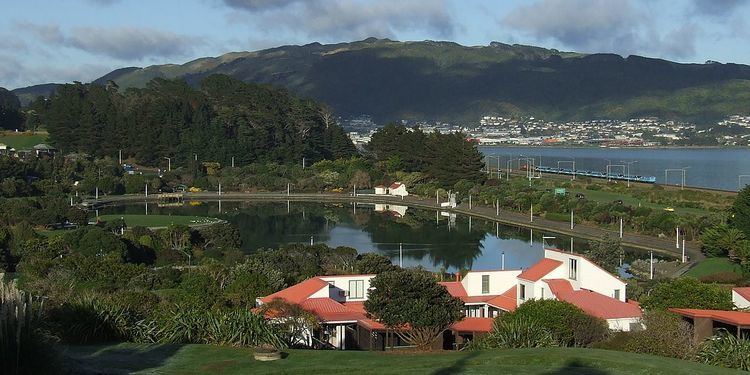First service 15 April 1991 | Status Operating | |
 | ||
Former operator(s) CityRail (1991 – 1995)Tranz Metro (1995 – 2001)Tranz Scenic (1995 – present) | ||
The Capital Connection is a long-distance commuter train between Palmerston North and Wellington on the North Island Main Trunk in New Zealand. It is operated by KiwiRail Scenic Journeys. The service began in 1991. It is the only unsubsidised commuter service in New Zealand.
Contents
History
The service started on Monday 15 April 1991 as the Cityrail Express, with "Cityrail EXPRESS Palmerston North - Wellington" emblazoned on carriage sides.
Operator
From 1991 the train was operated by New Zealand Rail suburban passenger division CityRail, which was re-branded Tranz Metro in 1995 when New Zealand Rail itself was rebranded Tranz Rail. In 2001, with the partial sale of Tranz Scenic (the long-distance passenger division of Tranz Rail), the company sought to separate its commercial passenger rail operations from its subsidised services (which remained in Wellington under Tranz Metro), operation of the train was transferred to Tranz Scenic.
Service
The train operates Monday-Friday from Palmerston North to Wellington in the morning, returning in the evening.
Weekend services
On Sunday 19 June 1994 a weekend service from Palmerston North to Wellington and return started. The power/baggage van, catering car and 50-seat (alcove-style with tables) day car (ex Masterton) made up the consist. It attracted minimal patronage and was withdrawn in 1994.
Future
Concerns were raised that once the Kapiti Line services were extended north from Paraparaumu to Waikanae, the Capital Connection would lose passengers. In 2010 KiwiRail stated it would consider changes after evaluating what impact the metro system has on the Capital Connection's patronage. The extension to Waikanae was opened in 2011. By July 2012 the future of the service seemed to be very uncertain. KiwiRail announced it would make a decision on the service in August 2012. Patronage dropped by 26,000 trips per annum (from 185,472 trips in the 2008-09 financial year to 159,641 in the 2011–12 financial year.)
The Greater Wellington Regional Council and the Horowhenua District Council proposed partial funding but needed the NZ Transport Agency (NZTA) to agree to continue the service. NZTA's public transport funding criteria require that a service must reduce traffic on a congested road. In August 2012 Greater Wellington Regional Council and Horizons (Manawatu-Wanganui Regional Council) proposed a business case for a subsidy which was evaluated by NZTA.
The business case argued that:
In March 2013 the Member of Parliament for Palmerston North, Iain Lees-Galloway, presented a petition of 2,000 signatures supporting the service at a parliamentary select committee hearing. In May 2014 he said that he was not surprised at the drop in patronage following a fare rise.
In April 2013 KiwiRail said to keep the service operating, it would have increased ticket prices by 40 percent, and have at least 61 passengers on board in each direction. But it only increased fares by 10% from May.
On 1 July 2015, KiwiRail confirmed, that funding had been approved by Horizons Regional Council and the Greater Wellington Regional Council signing off their Long Term Plans, including a subsidy for the service for another three years. KiwiRail Scenic Journeys said there would be maintenance and repairs for each of the carriages, at staggered intervals over the next 12 months, to improve the service.
In 2016 it was reported patronage on the service had increased for the first time in three years.
Truncation to Waikanae proposal
In November 2014, Palmerston North City Councillor Chris Teo-Sherrell suggested truncating the service to Waikanae, to connect with services operated by Tranz Metro.
Multi-service proposal
In December 2016, Palmerston North Mayor Grant Smith suggested the service should run more than once during the daytime. Smith argued the train could return to Palmerston North at 8:30am after arriving at Wellington in the morning, returning to Wellington for the evening run.
Rolling stock and motive power
The service began using standard NZR 56-foot carriages: the first of two power-baggage vans from the Bay Express, a 50-seat Southerner car, a 42-seat Northerner car and a 37-seat Northerner catering car. When the Northerner and Southerner cars were returned to their respective trains and patronage continued to increase a former Masterton commuter car was refurbished to the same standard, with the same 50 alcove-style seats as the Southerner car, but with sheepskin seat covers. Later, a former Endeavour car with luggage space at one end and a former Picton - Greymouth car, both from on the Masterton commuter run, were refurbished for the service. Later still, up to five more Masterton cars, a Northerner car, the second Northerner catering car and the sole InterCity spare buffet car saw service. Before these carriages were replaced, the service was regularly running with a van and eight cars.
British Rail carriages
On Monday 15 November 1999 a new train entered service, made up of seven (later eight) British Rail Mark 2 cars and the second former Southerner modular 11 kW power and baggage van, with 90 kW generator and larger luggage space made up from the middle and expanded non-handbrake end compartments. The new cars are about three metres longer than the older cars and more spacious inside, with more headroom, full air-conditioning, 60 seats per car (28 in the servery car), and twin power sockets at the foot of each pair of seats. Seating arrangement is both alcove and airline-style, using their British Rail InterCity 72 seats. Since October 2016, fire suppressed DFB class locomotives have been assigned to the service.
They have been repainted from Tranz Scenic standard "Cato blue" into Capital Connection livery.
